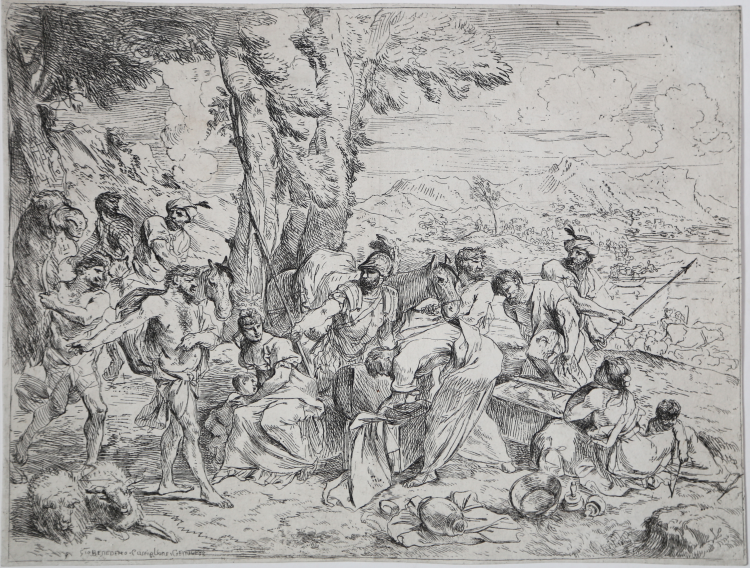




| Reference: | S37093 |
| Author | Giovanni Benedetto CASTIGLIONE detto "Il Grechetto" |
| Year: | 1640 ca. |
| Measures: | 332 x 250 mm |



| Reference: | S37093 |
| Author | Giovanni Benedetto CASTIGLIONE detto "Il Grechetto" |
| Year: | 1640 ca. |
| Measures: | 332 x 250 mm |
Etching, 1635 – 1640 ca, signed at lower left: 'GIO BENEDETTO Castiglione GENOVESE'. Second state, of four, with a black line, at the top in the sky, mesauring about 1 cm.
Good example, printed on contemporary laid paper, trimmed close to platemark, very good condition.
Depicted is a scene from the story of Jacob, in the book of Genesis (XXXI, 33 -35). After fleeing Laban’s house in the middle of the night, Jacob and his wives, Rachel and Leah, are overtaken by Laban, who searches for the household idols stolen by Rachel in an attempt to protect Jacob from another twenty years of labor under her father’s rule.
According to Bellini, the influence of Poussin suggests a date of 1635-40, while the sharpness of the lines resembles the style of Pietro Testa.
A drawing of the same subject, but with variations, perhaps a partial preparatory study for this etching, is preserved in the National Gallery of Scotland, Edinburgh, inv. no. D 700.
Bibliografia
Bartsch XXI.11.4; Bellini in TIB 1985, 4602.004.S2.
Giovanni Benedetto CASTIGLIONE detto "Il Grechetto" (Genova 1616 - Mantova 1670)
|
His origin and his edication in Genua led Castiglione to make acquaitance with the Flemish painting, especially through Jaan Roos e Van Dyck from whom he took the warm, vibrating chromatism.
He lived in Rome from 1632 to 1635 and from 1647 to 1651; among the two periods in Rome, he lived in Naples and he also started studying the intellectualistic classicism of Poussin.
His favourite subjects, both in painting and engraving, were taken from the classical moralism of Stoicism, very typical in Poussin, which enabled him to create his own peculiar repertoire, much more refined in comparison with contemporary artists.
He spent his last working years in Mantua, at the Duke’s Palace; the production of this period enhances his chromatism and the visionary elements of his previous production.
Castiglione has been a silful engraver; he loved this particular art for he thought it was the main mean to widespread his iconography. He was the first, in Italy, to appreciate and imitate Rembrandt.
|
Giovanni Benedetto CASTIGLIONE detto "Il Grechetto" (Genova 1616 - Mantova 1670)
|
His origin and his edication in Genua led Castiglione to make acquaitance with the Flemish painting, especially through Jaan Roos e Van Dyck from whom he took the warm, vibrating chromatism.
He lived in Rome from 1632 to 1635 and from 1647 to 1651; among the two periods in Rome, he lived in Naples and he also started studying the intellectualistic classicism of Poussin.
His favourite subjects, both in painting and engraving, were taken from the classical moralism of Stoicism, very typical in Poussin, which enabled him to create his own peculiar repertoire, much more refined in comparison with contemporary artists.
He spent his last working years in Mantua, at the Duke’s Palace; the production of this period enhances his chromatism and the visionary elements of his previous production.
Castiglione has been a silful engraver; he loved this particular art for he thought it was the main mean to widespread his iconography. He was the first, in Italy, to appreciate and imitate Rembrandt.
|